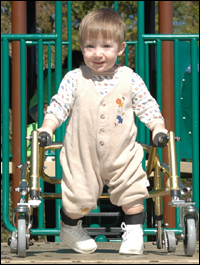Learn what spina bifida is, how it can be
prevented, and where to find resources for those
affected.
Spina bifida is a major birth defect of a baby's
spine. It is one of the most common, permanently
disabling birth defects in the United States.
Spina bifida occurs within the first few weeks of
pregnancy, often before a woman knows she is
pregnant. It happens when the spine and back bones
do not close all the way. When this happens, the
spinal cord and back bones do not form as they
should. A sac of fluid comes through an opening in
the baby's back. Much of the time, part of the
spinal cord is in this sac and it is damaged.
Most children born with spina bifida live full
lives, though they often have lifelong disabilities
and need many surgeries. Some of the problems that a
person born with spina bifida might face include:
- Not being able to move lower parts of their
body. (Some might need to use crutches, braces,
or wheelchairs to get around.)
- Loss of bowel and bladder control. (Some
might have to wear protective clothing. Others
learn new ways to empty their bladders and
bowels.)
- Fluid building up and putting pressure on
the brain (hydrocephalus), which needs to be
fixed with an operation.
- Learning disabilities.
- Allergy to latex (a created material found
in some rubber-type products such as balloons or
hospital gloves).
All children born with spina bifida don't have
the same needs. Some children have problems that are
much more severe than others. Even so, with the
right care, most of these children will grow up to
lead full and productive lives.
 Read about one family's experience Living with
Spina Bifida. (12 pages, 15.2 MB)
Read about one family's experience Living with
Spina Bifida. (12 pages, 15.2 MB)
Most, but not all, cases of spina bifida can be
prevented.
Folic acid is a B vitamin that the body needs to
make healthy new cells. If a woman has enough folic
acid in her body before and during pregnancy,
her baby is less likely to have spina bifida or
another defect of the brain or spine. Women need to
take folic acid every day, starting before they get
pregnant.
Every woman who could possibly get pregnant
should take 400 micrograms (400 μg or 0.4 mg) of
folic acid daily in a vitamin or in foods that have
been enriched with folic acid.
Learn more about folic acid, how to get enough each
day, and where to find free education materials.
|
Resources
for Families and Individuals Affected by
Spina Bifida |